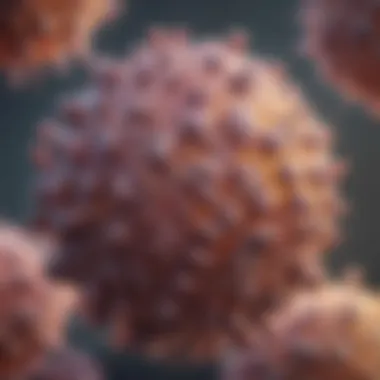Glioma Prognosis: Understanding Patient Outcomes


Intro
Gliomas represent a heterogeneous group of tumors that arise from glial cells in the brain and spinal cord. Understanding the prognosis of gliomas is critical for guiding treatment and providing patients and their families with realistic expectations. Prognosis is influenced by a multitude of factors, including tumor type, grade, molecular characteristics, and patient demographics.
This article aims to provide a comprehensive examination of glioma prognosis, addressing significant aspects like survival statistics, treatment options, and the role of genetic and molecular markers. Additionally, the article will explore recent advancements in glioma research and the development of prognostic tools that assist clinicians in making informed decisions.
Background and Context
Overview of the Research Topic
Gliomas are categorized into various types, mainly differentiated by their cellular origin and grade. These tumors can vary significantly in behavior, from indolent to highly aggressive forms. Understanding glioma prognosis is an evolving field, notably due to recent scientific advances that have shed light on the molecular underpinnings of these tumors.
Historical Significance
Historically, gliomas have posed substantial challenges for healthcare providers. Treatment options have evolved from basic surgical interventions to sophisticated combinations of chemotherapy and radiation. Previous studies highlighted survival rates that were less favorable than they are today, emphasizing the importance of developing precise prognostic tools. In recent years, the integration of genetic profiling in treatment planning has shifted the landscape of glioma management.
"Evidence-based prognostic markers play a vital role in informing treatment strategies for glioma patients." - Anon
Key Findings and Discussion
Major Results of the Study
Recent findings indicate that molecular markers such as O6-methylguanine-DNA methyltransferase (MGMT) promoter methylation and isocitrate dehydrogenase (IDH) mutations are pivotal in determining patient outcomes. The presence of these markers can significantly alter survival predictions. Furthermore, the distinction between lower-grade gliomas and high-grade gliomas is crucial, as high-grade gliomas generally result in poorer prognosis.
Detailed Analysis of Findings
The following key points illustrate the nuances in glioma prognosis:
- Tumor Type and Grade: Different types of gliomas, such as astrocytomas and oligodendrogliomas, present distinct survival statistics.
- Update on Treatment Options: Advances in targeted therapy and immunotherapy are changing treatment paradigms. The engagement of drugs like temozolomide has been successful in extending survival for specific glioma types.
- Role of Genetic Markers: The identification of relevant genetic markers enhances personalized treatment planning. This shifts the focus from traditional methods to a more tailored approach based on individual tumor biology.
In summary, glioma prognosis is multifaceted, influenced by various clinical and molecular factors. Understanding these elements is crucial for medical professionals, researchers, and patients seeking clarity about treatment paths and outcomes. The next sections will delve deeper into survival statistics and resourceful prognostic tools.
Understanding Glioma
Gliomas are a critical subject in neuroscience and oncology due to their significant impact on patient health and quality of life. Understanding gliomas involves exploring their characteristics, types, and effects on prognosis. This section aims to lay a solid foundation for discussing the prognosis of glioma patients later in the article.
Definition and Classification
Gliomas are a type of tumor that originates in the glial cells of the brain. These tumors can be classified based on the type of glial cell from which they arise, such as astrocytes, oligodendrocytes, and ependymal cells. This classification is essential for determining the prognosis and treatment plan for patients. Understanding the differences among histological types helps clinicians decide the best course of action for each patient.
Epidemiology
Epidemiological studies reveal that gliomas account for about 30% of all brain tumors and approximately 80% of all malignant brain tumors. Awareness of their incidence and prevalence is crucial, as it informs healthcare providers about which populations may be more affected. Factors such as age, gender, and geographical location play a role in glioma occurrence, helping to elucidate potential risk factors associated with these tumors.
Histological Types of Gliomas
Histological types of gliomas encompass several varieties, each with unique characteristics that bear significance in prognosis and treatment:
Astrocytomas
Astrocytomas arise from astrocytes and are classified as low-grade or high-grade. Low-grade astrocytomas typically have a better prognosis than high-grade variants like glioblastoma. Key features include cellular density and atypical mitotic activity. Their significance lies in their prevalence and variability in aggressiveness, making it essential to understand them for effective management.
Oligodendrogliomas
Oligodendrogliomas originate from oligodendrocytes and tend to have a more favorable response to treatment compared to astrocytomas. A crucial characteristic of oligodendrogliomas is the presence of the 1p/19q co-deletion which impacts treatment choices and prognosis. Their unique genetic profile serves as a vital consideration in developing targeted therapies, enhancing the utility of molecular approaches in clinical settings.
Ependymomas
Ependymomas come from ependymal cells and can occur anywhere in the central nervous system. They are notably categorized based on their location and histological features. A key aspect of ependymomas is their potential for recurrences and the varying treatment responses seen across different grades. Understanding these factors is vital for predicting patient outcomes and planning follow-up care effectively.
Mixed Gliomas
Mixed gliomas contain multiple types of glial cells, with an example being an oligoastrocytoma. Their prognosis can vary widely depending on the mix of cell types present. The presence of diverse cellular components characterizes mixed gliomas, which can complicate treatment approaches and prognosis assessments. These unique features necessitate careful analysis in clinical practice, contributing to the complexities of glioma management.


This section highlights the diverse nature of gliomas and sets the context for understanding their prognostic implications in the following chapters.
Prognosis in Glioma Patients
The prognosis for glioma patients is a central topic in understanding the broader implications of this complex condition. It encompasses various elements that directly influence patient outcomes and quality of life. Prognosis gives patients and their families vital information regarding survival expectations and treatment paths. The consideration of prognosis can help guide treatment decisions, allow for upfront planning, and aid in the emotional preparation of patients and their support networks.
Survival Rates Overview
Survival rates serve as a foundational aspect of prognosis. These metrics provide a statistical framework that helps to gauge the average outcomes for patients diagnosed with gliomas. Their complexity varies significantly depending on several factors including the type of glioma, its location, and the patient’s overall health condition.
Research indicates that the survival rates for glioma patients are generally divided into categories based on tumor grade. Lower-grade gliomas often present more favorable outcomes compared to high-grade variants. As paradigms shift with medical advancements, survival data evolve, necessitating continuous updates to clinical expectations.
A crucial aspect of survival rates is the median survival time, which represents the point at which half of the patients have survived and half have not. For instance, a glioblastoma diagnosis may present a median survival of approximately 15 months, significantly differing from outcomes expressed for lower-grade tumors. These statistics influence not only clinical decisions but also the hope and psychological processing of patients and families.
Factors Affecting Prognosis
Prognosis in glioma patients is significantly affected by several key factors. Understanding these elements can provide insight into how each aspect contributes to overall outcomes.
Patient Age
Patient age is an essential consideration in prognosis. Studies show that younger patients generally experience better outcomes compared to older patients. This is frequently attributed to the resilience of younger bodies against rigorous treatments and potentially more favorable tumor biology. Younger patients might respond more effectively to innovative therapies and tend to tolerate side effects better.
The unique feature of age is that it often correlates with a range of biological factors that affect tumor behavior. However, older patients often face other health issues that complicate treatment pathways. Therefore, while younger age is an advantage, it is not an absolute guarantee of better outcomes.
Performance Status
Performance status refers to a patient's overall well-being and ability to perform daily activities. It is a strong predictor of treatment tolerance and overall prognosis. Tools such as the Karnofsky Performance Status scale help to quantify this aspect.
Patients with a higher performance status exhibit better resilience and are at a higher likelihood of benefiting from aggressive treatment options. Conversely, those with a lower performance status often face challenges that limit their treatment options and adversely impact their prognosis. This aspect illustrates the importance of ongoing assessments throughout treatment.
Genetic Markers
Genetic markers play a noteworthy role in glioma prognosis. Certain mutations, such as those found in the ID or TP53 genes, can provide insight into tumor behavior and patient outcomes. For example, IDH-mutant gliomas tend to have a better prognosis than their wild-type counterparts.
The examination of genetic markers not only informs treatment strategies but also assists in prognostication. However, the knowledge of these markers brings complexities. While they can signal more favorable outcomes, not all patients with beneficial markers will have the same individual prognosis, highlighting the intricacies of personalized medicine.
Volume of Tumor
The volume of the tumor, often described in terms of its size and extent, is another critical factor in assessing prognosis. Larger tumors can be more symptomatic and invasive, leading to poorer outcomes. Surgical resection aims to reduce tumor burden and improve prognosis; however, the feasibility of complete removal often depends on the tumor's location and involvement with critical brain structures.
Research suggests a correlation between tumor volume and survival; smaller, more resectable tumors often have better prognostic indicators. Therefore, understanding the volume of the tumor can help shape treatment decisions and inform patients about their prognosis.
Molecular and Genetic Factors
Molecular and genetic factors play a crucial role in understanding glioma prognosis. These elements help to elucidate the biological behavior of tumors, offering insights into their growth patterns, potential treatment responses, and overall patient outcomes. Knowledge of these factors supports a more personalized approach to treatment, which can enhance effectiveness and reduce unnecessary side effects.
Genetic alterations in gliomas can predict how aggressive a tumor may be and how a patient might respond to specific therapies. The identification of these markers allows for better prognostic stratification and guides therapeutic decisions.
Role of IDH Mutations
Isocitrate dehydrogenase (IDH) mutations are significant in glioma biology. They are commonly found in lower-grade gliomas and secondary glioblastomas. The presence of an IDH mutation typically indicates a better prognosis. Research shows that patients with these mutations have longer survival rates compared to those with wild-type IDH genes. The mutated enzyme alters the metabolic pathway of glioma cells, which may influence how tumors respond to treatments.
MGMT Promoter Methylation
MGMT (O6-methylguanine-DNA methyltransferase) promoter methylation is another critical genetic factor. Methylation results in the silencing of the MGMT gene, rendering glioma cells less capable of repairing DNA damage caused by alkylating agents, such as temozolomide. Studies suggest that patients with MGMT promoter methylation often have improved outcomes with chemotherapeutic strategies. Therefore, testing for this modification is essential in tailoring treatment plans effectively.
25q Deletion and Prognosis
The 25q deletion involves the loss of genetic material on chromosome 25 and is associated with specific glioma types. This genetic alteration is linked with poorer prognosis and aggressive tumor behavior. Patients with this deletion may experience a shorter survival time and higher recurrence rates. Understanding 25q deletion can assist in predicting disease progression and informing treatment options aimed at controlling tumor growth.
In summary, the study of molecular and genetic factors in gliomas provides valuable insights that can significantly influence prognostic assessments and treatment strategies. Identifying markers like IDH mutations, MGMT promoter methylation, and 25q deletion, clinicians can make more informed decisions that align with the individual characteristics of each tumor.
Diagnosis and Prognostic Tools


The section of Diagnosis and Prognostic Tools serves a critical role in understanding glioma prognosis. Accurate diagnosis is the cornerstone of effective treatment planning and management. Having the right tools allows for better predictions of outcomes and personalized strategies. This section explores various modalities that enhance our understanding of gliomas, allowing healthcare professionals to make informed decisions based on detailed information and analysis.
Imaging Techniques
MRI Characteristics
Magnetic Resonance Imaging (MRI) is a vital element in diagnosing gliomas. This imaging technique offers a detailed view of brain structures, allowing clinicians to assess tumor size, location, and characteristics. The key characteristic of MRI is its high-resolution capability. This quality makes it widely used in the assessment of brain tumors. MRI can detect subtle changes in the brain's anatomy, which is crucial for understanding glioma development and progression.
One unique feature of MRI is its ability to provide contrast enhancement. This enhancement helps to distinguish tumor tissue from surrounding healthy brain tissue. The major advantage lies in its non-invasive nature and lack of radiation exposure. However, MRI may also have limitations. For example, some patients may experience discomfort due to prolonged scanning times. Additionally, specific artifacts may occur, potentially complicating interpretation.
PET Scan Utility
Positron Emission Tomography (PET) scans have an increasing role in glioma diagnosis and prognosis. This imaging technique provides metabolic information about the tumor. The key characteristic of PET scans is their ability to visualize glucose consumption in brain cells. Tumor cells often exhibit increased glucose metabolism compared to normal cells, providing useful insights.
The unique feature of PET scans is their functional imaging capability. This allows doctors to evaluate tumor aggressiveness and help in treatment planning. The major benefit of PET lies in detecting recurrence; it can reveal active tumor regions even when MRI shows no structural changes. However, PET has its disadvantages; for instance, it involves exposure to radioactive substances, and the cost may be higher than traditional imaging methods.
Biopsy and Pathology
Biopsy is crucial for definitive diagnosis and characterizing gliomas. This procedure involves removing a tissue sample for microscopic analysis. Pathology provides insights into tumor grading and specific types, influencing treatment options. It enables pathologists to determine whether a glioma is benign or malignant. Furthermore, the presence of certain cellular features informs prognosis, such as cell density and mitotic activity.
Biopsy methods vary, including stereotactic and open biopsy. Each method has its own set of considerations and risks. Stereotactic biopsy is less invasive and has a lower complication rate. However, it may not collect enough tissue for comprehensive analysis.
Prognostic Scoring Systems
WHO Grading
The WHO grading system is a standardized method for classifying gliomas based on histologic features. This system categorizes tumors from grades I to IV, reflecting their aggressiveness and potential outcomes. The key characteristic of the WHO grading system is its established criteria for tumor evaluation, including cellularity, nuclear atypia, and mitotic activity.
The advantage of WHO grading is its wide acceptance in clinical practice. It provides a framework for communication among healthcare professionals. However, its limitations include variability in interpretation among pathologists, which can affect consistency in diagnosis.
RGMI Scale
The RGMI (Revised Glioma Molecular Index) scale evaluates gliomas based on genetic and molecular markers. This scoring system assesses multiple factors, including genetic alterations and tumor grade. The key characteristic of the RGMI scale is its incorporation of molecular data, moving beyond traditional histology.
The benefit of the RGMI scale is its ability to provide more nuanced prognostic information. It can guide treatment decisions and predict outcomes better than traditional methods alone. However, the complexity of genetic assessments can pose challenges, including costs and the need for specialized knowledge.
"The accuracy of diagnosis and prognosis in glioma management profoundly influences patient outcomes, making these tools crucial in clinical practice."
In sum, accurate diagnosis and effective prognostic tools provide a strong basis for understanding glioma prognosis. These elements enable healthcare providers to tailor treatments and improve outcomes for patients diagnosed with gliomas.
- Imaging techniques, including MRI and PET scans, offer insights into tumor characteristics.
- Biopsy provides essential tissue for definitive diagnosis.
- Prognostic scores like WHO grading and RGMI enhance stratification of patients and treatment planning.
Treatment Modalities
The section about treatment modalities is crucial in understanding glioma prognosis. Each therapeutic option has specific benefits and considerations which directly affect patient outcomes. Treatment strategies often depend on various factors, including tumor type, location, and genetic characteristics. Understanding these modalities can help guide both clinical decisions and patient expectations.
Surgical Options
Surgery is often the first line of treatment for gliomas. The primary goal is to remove as much tumor as possible while preserving surrounding healthy tissue. The extent of resection plays a significant role in prognosis. A total resection tends to lead to better outcomes compared to partial resection.
However, surgical options vary based on glioma grades and locations. Low-grade gliomas may require less aggressive surgical intervention compared to high-grade tumors. For some tumors in eloquent areas of the brain, neurosurgeons may use advanced techniques like intraoperative mapping. These techniques help in minimizing damage to critical brain functions.
- Benefits of Surgical Treatment:
- Reduces tumor burden
- Often provides immediate symptomatic relief
- May allow for better effectiveness of subsequent therapies
"Surgical resection remains the cornerstone of treatment for many gliomas, often making the difference in patient survival rates."
Radiotherapy
Radiotherapy is typically employed after surgery for patients with high-grade gliomas. It helps target residual tumor cells that may not have been removed during surgery. Radiotherapy can also be considered as a primary treatment in cases where surgery is not feasible.
The main types include external beam radiotherapy and stereotactic radiosurgery. Each of these has a unique approach and context for use. Specific dosing schedules, such as fractionated radiotherapy or whole brain irradiation, are considered according to individual cases.


- Importance of Radiotherapy:
- Reduces relapse rates
- Can improve overall survival in high-grade gliomas
- Specific treatment plans tailor to individual needs
Chemotherapy
Chemotherapy may supplement surgical and radiological treatments, particularly in treating aggressive gliomas like glioblastoma multiforme. Temozolomide is a commonly used drug, showing effectiveness in prolonging survival in certain patient populations.
The scheduling of chemotherapy varies. It can be used concurrently with radiotherapy or as an adjunct treatment after initial therapies. New research is increasingly focusing on personalized medicine approaches in chemotherapy regimens to optimize results.
- Key Points About Chemotherapy:
- Targets cancer cells throughout the body
- May mitigate the risk of recurrence
- Ongoing studies examine more effective drug combinations
Targeted Therapies
Targeted therapies represent a shift in how gliomas are treated. Unlike traditional treatments, they focus on specific molecular targets associated with glioma growth. Such therapies may include monoclonal antibodies and small-molecule inhibitors. These therapies can have lower toxicity and specific action on tumor cells, potentially leading to improved outcomes.
Genetic profiling of tumors allows clinicians to identify suitable candidates for targeted therapies. This personalization can lead to a more effective treatment approach tailored to the individual’s unique cancer characteristics.
- Benefits of Targeted Therapies:
- Less impact on healthy tissues
- Potentially better response rates compared to conventional chemotherapy
- Research into new targets continues to expand therapy options
Understanding these treatment modalities provides critical insights into the strategic management of gliomas. The effectiveness and appropriateness of each treatment are shaped by ongoing research, patient profiles, and evolving medical practices.
Current Research and Future Directions
In the realm of glioma prognosis, ongoing research is pivotal. This section highlights critical advancements and innovation in treatments and methodologies that may alter future outcomes for patients. Understanding current research trends sheds light on the evolving landscape of glioma management. Researchers strive to establish more effective therapies, aiming to enhance patient survival and quality of life. The integration of novel technologies, genetic research, and biomarker discovery could immensely influence the way gliomas are treated, emphasizing precision medicine tailored to individual profiles.
Emerging Therapies
Emerging therapies in glioma treatment provide significant hope for patients. These include immunotherapies, which harness the body’s immune system to target tumor cells more effectively than traditional treatments. Techniques such as CAR-T cell therapy show promise, wherein T cells are engineered to by pass the tumor immunosuppressive environment. Furthermore, experimental agents like oncolytic viruses are being explored to selectively infect and destroy glioma cells without harming surrounding healthy tissue. These therapies open new avenues for targeting tumor resilience, which is a significant issue in glioma treatment. The potential personalized approaches based on molecular profiling helps in selecting specific therapies that may yield better outcomes.
Clinical Trials and Innovations
Clinical trials represent a cornerstone of glioma research. They provide valuable data on the efficacy and safety of novel treatments. Currently, numerous trials are focusing on combining existing modalities, such as chemotherapy and radiation with targeted therapies. This combination strategy aims to overcome the limitations of each treatment. For instance, trials examining the synergy between chemotherapy and immune checkpoint inhibitors portray the relevance of adaptive treatment strategies. Innovations in trial designs, including adaptive trials, allow flexibility in modifying treatment based on interim results, making them more responsive to patient needs.
"Through clinical trials, we aim to redefine the prognosis and treatment landscape of gliomas, offering hope where there has traditionally been little."
Ethical Considerations in Treatment
As advancements in glioma research emerge, ethical considerations become increasingly crucial. The introduction of experimental therapies raises questions regarding informed consent and the balance between potential benefits and risks. Ensuring that patients and families fully understand their options is essential for ethical practice. Additionally, equitable access to these therapies is a pressing concern, as disparities in healthcare could affect outcomes. As researchers explore innovative treatment options, addressing these ethical implications helps maintain trust and integrity within the medical community. It is vital for healthcare professionals to navigate these ethical dilemmas while prioritizing patient autonomy and welfare.
Concluding Thoughts
Understanding glioma prognosis is vital for several reasons. It links directly to patient management and therapeutic strategies. This article has explored various aspects of glioma, providing insights that are critical for both clinicians and families facing this challenging diagnosis. The prognosis of glioma can significantly vary based on multiple factors, including tumor type, patient age, treatment options, and genetic markers. Each element plays a role in shaping the future for the patient and influences decision-making strategies for care.
One key takeaway is the role of molecular and genetic factors in prognostic assessments. Information on IDH mutations, MGMT promoter methylation, and other genetic markers add another layer to understanding individual patient outcomes. As research advances, it is likely that these factors will become even more integrated into standard practice, improving prognostic accuracy.
Moreover, the insights gained from imaging techniques and biopsy analyses are essential. They guide clinicians in not only diagnosing gliomas but also in tailoring appropriate treatment plans. The use of prognostic tools such as the WHO Grading System enriches the understanding of how aggressive a tumor may be, and influences both treatment choices and patient discussions.
In summary, the implications of gleaning a clearer understanding of glioma prognosis cannot be overstated. It spans from defining treatment paths to addressing the emotional and psychological needs of patients and their families.
Summary of Key Points
- Glioma prognosis depends on various elements:
- Prognostic tools enhance diagnostic accuracy and treatment planning.
- Recent research continues to evolve the landscape of glioma treatment options.
- Tumor type and histological classification.
- Age and overall health of the patient.
- Genetic mutations and other molecular factors.
Implications for Patients and Families
For patients and their families, understanding glioma prognosis presents several implications. First, it helps in setting realistic expectations regarding treatment outcomes and survival chances. Knowing survival rates and influencing factors can empower patients and families in discussions with healthcare providers.
Information on treatment modalities, such as surgery, chemotherapy, and targeted therapy, can guide family conversations about preferences and priorities. Additionally, it allows families to prepare for potential challenges while fostering a sense of agency over the situation.
Another consideration is emotional preparedness. Families equipped with knowledge can better manage the psychological impact of a glioma diagnosis. They can seek out support groups or counseling, which should be considered part of holistic care.
Ultimately, an informed patient and family can lead to a collaborative relationship with healthcare teams, enhancing the overall care experience. Seeking knowledge is empowerment, and it aids in navigating the complexities of glioma treatment and prognosis.







